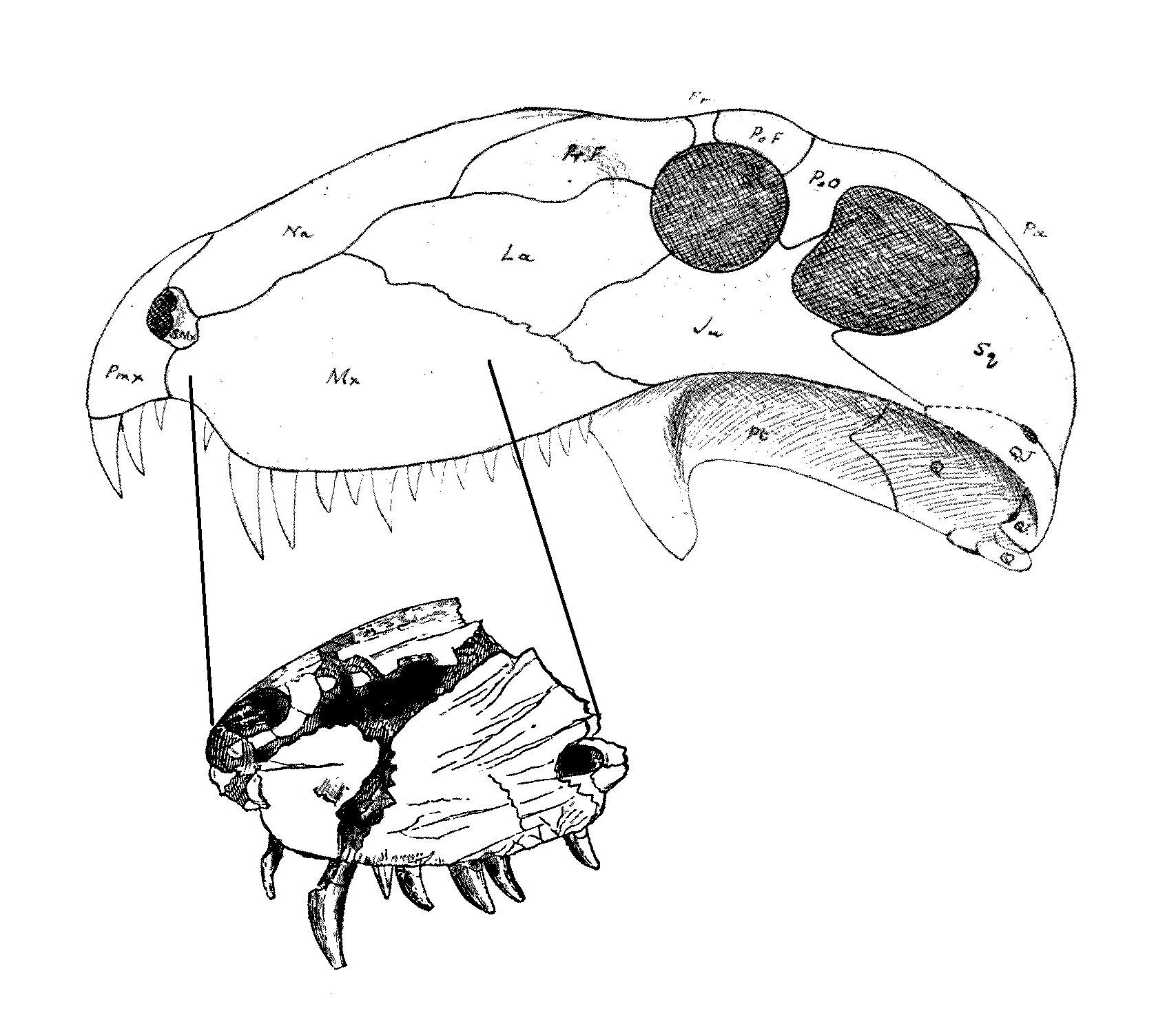Bathygnathus Leidy, 1853
B. borealis Leidy, 1853
Kungurian, Early Permian
Red Beds, Prince Edward Island, Canada
Holotype- (ANSP 9524) partial premaxilla, incomplete maxilla, anterior nasal, seven teeth
Bathygnathus snout (bottom) compared to Dimetrodon skull (top), taken from a Wikipedia image by Bogdanov.
Comments- The holotype was discovered in 1845 and originally briefly described by Leidy (1853) as the mandible of a reptile, and later (1854, 1855) described in more depth as a lizard ("lacertian"). Cope (1868) suggested it was related to Dryptosaurus and provisionally placed it in his Goniopoda (=Theropoda) in 1870. Huene (1902) referred it to his theropod family Zanclodontidae, believing it might be synonymous with Teratosaurus. It was also commonly referred to the Amphisauridae (e.g. Marsh, 1882), and the Anchisauridae which replaced it (e.g. Marsh, 1885) when these were thought to be theropod groups. Owen (1876) correctly identified the specimen as an upper jaw and suggested a relationship to theriodonts (and Lycosaurus in particular) based on the presence of a canine tooth, reduced incisor and other characters. This was not confirmed until Case (1905) and Huene (1905) independently reidentified Bathygnathus as a "pelycosaurian" synapsid, Case believing it to be either Dimetrodon or Naosaurus (a junior synonym of Edaphosaurus that was mistakenly given a Dimetrodon skull). It was referred to Sphenacodontidae by Romer and Price (1940), and Sphenacodontinae in particular by Reisz (1986). However, Reisz et al. (1992) determined that the other subfamilies are invalid, as Haptodus is basal to sphenacodontids+therapsids, while Secodontosaurus is deeply nested within Sphenacodontidae. Using their analysis, Bathygnathus is a sphenacodontoid based on the lacrimal not contacting the naris, strongly convex ventral maxillary edge, canines more than twice as long as other maxillary teeth, less than four maxillary pre-canines, and serrated teeth. Within Sphenacodontidae, it seems to be closer to Dimetrodon and Secodontosaurus than Sphenacodon and Ctenospondylus based on the elongate maxillonasal suture.
References- Leidy, 1853. [Remarks on Bathygnathus borealis]. Proceedings of the Academy of Natural Sciences of Philadelphia. 6, 404.
Leidy, 1854. On Bathygnathus borealis, an extinct saurian of the New Red Sandstone of Prince Edward Island. Proceedings of the Academy of Natural Sciences of Philadelphia, second series. 2(4), 327-330.
Leidy, 1855. On Bathygnathus borealis, an extinct saurian of the New Red Sandstone of Prince Edward's Island. American Journal of Science, series 2. 19, 444-446.
Cope, 1868. Remarks on extinct reptiles which approach birds. Proceedings of the Academy of Natural Sciences of Philadelphia. 19, 234-235
Cope, 1870. Synopsis of the extinct Batrachia, Reptilia and Aves of North America. Transactions of the American Philosophical Society. 14, 1-252.
Owen, 1876. Evidences of theriodonts in Permian deposits elsewhere than in South Africa. Quarterly Journal of the Geological Society of London. 32, 352-366.
Leidy, 1881. Remarks on Bathygnathus borealis. Journal of the Academy of Natural Sciences of Philadelphia, second series. 8(4), 449.
Marsh, 1882. Classification of the Dinosauria. American Journal of Science. 23, 81-86.
Marsh, 1885. On the classification and affinities of dinosaurian reptiles. Report of the British Association for the Advancement of Science. 1884, 763.
Huene, 1902. Übersicht über die Reptilien der Trias [Review of the Reptilia of the Triassic]. Geologische und Paläontologische Abhandlungen (Neue Serie). Gustav Fischer Verlag, Jena. 6, 1-84.
Case, 1905. Bathygnathus borealis Leidy and the Permian of Prince Edward Island. Science. 22(550), 52-53.
Huene, 1905. Pelycosaurier im deutschen Muschelkalk. Neues Jahrbuch fur Minerologie, Geologie und Paleontologie. 20, 321-353.
Case, 1907. Revision of the Pelycosauria of North America. 176 pp.
Romer and Price, 1940. Review of the Pelycosauria. Geological Society of America Special Paper. 28, 538 pp.
Langston, 1963. Fossil vertebrates and the Late Palaeozoic Red Beds of Prince Edward Island. National Museum of Canada, Bulletin. 187, 36 pp.
Reisz, 1986. Pelycosauria. Handbuch der Paläoherpetologie. 17A, 102 pp.
Spalding, 1995. Bathygnathus, Canada's first "dinosaur". in Sarjeant (ed.). Vertebrate Fossils and the Evolution of Scientific Concepts. 245-254.

I wondered why you wanted me to get you this paper, heh. :)
ReplyDelete